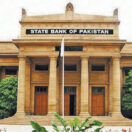By Mehtab Haider
Published in The News on September 02, 2023
ISLAMABAD: A finance ministry report has painted a dismal economic picture, showing total public debt has gone up from Rs23.02 trillion in 2017-18 to Rs54.39 trillion till March 2023, and external debt and liabilities went up from $95 billion in 2017-18 to $126.1 billion till end of March 2023.
Over the last five years, the total public debt of the government has exceeded the prescribed limit of 60 per cent of GDP, under the FRDL Act. This is primarily due to consistent fiscal deficits, averaging 6 per cent of GDP since 2010, which have led to a rapid build-up of debt. The TPD can increase due to both budgetary and non-budgetary factors, such as unfavourable movements in interest and exchange rates and the realisation of contingent liabilities.
The Fiscal Risk Statement (FRS) for 2023-24 identified 10 key sources of fiscal risks, including macroeconomic instability, rising debt, loss-making state-owned enterprises (SOEs) and others that might lead to potential threats and uncertainty.
“The inflation outlook has deteriorated, and there is heightened risk to external stability,” the Fiscal Risk Statement for 2023-24, released by the finance ministry, disclosed on Friday.
It added that Pakistan’s external debt constitutes 40.8 per cent of total public debt, which may make the government’s fiscal position vulnerable in the face of high current account deficits, low foreign exchange reserves and a weakening exchange rate.
A lack of foreign exchange reserves, coupled with large external payments, has resulted in liquidity issues and destabilised the exchange rate and domestic interest rates, further increasing the burden of external loans that are measured in local currency.
The finance ministry ranked loss making public corporations and environmental risks into category of High fiscal risk, while macroeconomic risks and policy implementation as Medium risks. The public private partnership (PPP) has been categorized as low risk.
In macroeconomic risks, the FRS for 2023-24 illustrates that the fiscal position demonstrates vulnerability to key macroeconomic variables, including GDP growth, interest rates, inflation, and exchange rate. The federal government exposure to SOEs, in the form of outstanding stock of loans and guarantees, stood at 9.7 per cent of GDP in FY2021; Circular debt (the payment shortfall created primarily because of non-payment of arrears and liabilities, transmission and distribution losses, as well as delays in charging periodical tariff adjustments).
On debt, Public and Publicly Guaranteed Debt (PPGD), stock reached 78.4 per cent of GDP at the end of FY2022; External debt, which entails currency risk, constitutes about 37 per cent of the total public debt; the fixed-rate debt portfolio has decreased in recent years and currently stands at only 26 per cent of total public debt, increasing refinancing risks.
Further, the average time to maturity of domestic debt was 3.6 years for FY2022. The government guarantees have become another source of headache for the government as guarantees stock stood at 4.5 per cent of GDP in FY2022 although guarantees issued against commodity operations are not part of the guarantee stock, as they are self-liquidating.
In Pakistan, the inflation rate has been volatile in recent years, influenced by various factors such as currency devaluation, energy, and food prices in global market. The Pakistani rupee has experienced significant depreciation in recent years, influenced by various risk factors such as trade imbalances, external debt, political instability, and global economic conditions. The State Bank of Pakistan (SBP) is actively responding to increasing inflation by raising the policy rate.
Moreover, the government is also focusing on taking effective policy, administrative and relief measures to control inflation and stabilise the economy. A slow but steady recovery of the economy is expected. According to provisional estimates of Pakistan Bureau of Statistics, Pakistan’s real GDP growth rate was 0.29 per cent in FY2023. Over the medium-term, growth was expected to rise to the levels even higher than five years (FY2018-FY2022) average growth rate of 4.0 per cent and eventually reach 5.5 per cent in FY2026. A gradual decrease in the inflation rate due to improvement in domestic and global factors and PKR stabilisation are expected over the medium term.
The inflation outlook has deteriorated, and there is heightened risk to external stability. The uncertainty surrounding the future adjustment path in energy prices is the main upside risk to the inflation outlook. However, a potential moderation in international commodity prices may contribute to a reduction in inflation. Further, exchange rate adjustments, passing on the impact of energy price increases, and interest rates on higher side would enable the prices to decline over the medium term. Subsequently, it would follow the expansionary monetary policy and improvement in fiscal space in view of decline in mark-up payments. As such, the stabilisation measures taken during the last one year can bring macroeconomic and fiscal benefits in the medium-term.
A more significant than expected slowdown in global demand could have a negative impact on Pakistan’s export outlook and workers’ remittances. Furthermore, global, and domestic uncertainty also pose a downside risk to this forecast. On the upside, a larger than anticipated slowdown in domestic demand or a relatively sharp fall in global commodity prices could improve the current account deficit and reduce fiscal risk.






